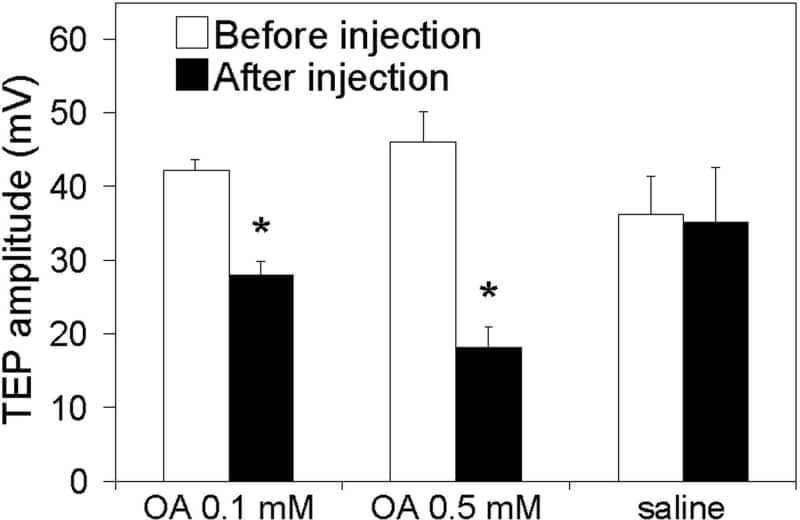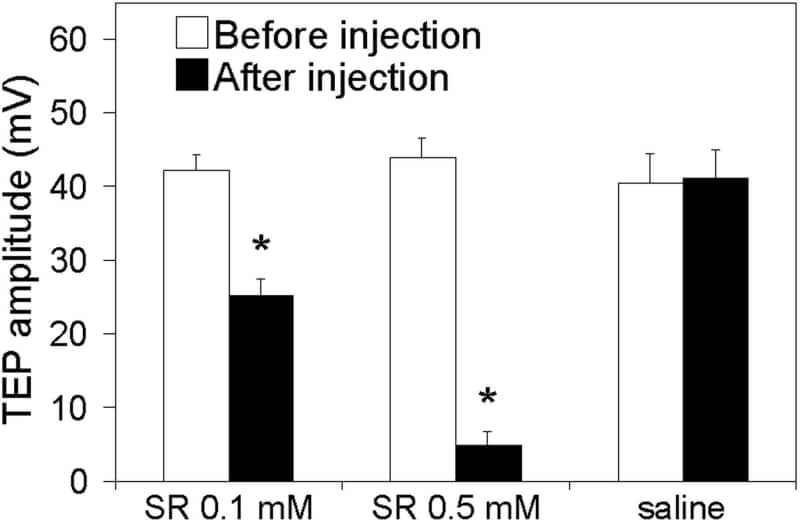Octopamine (OA) and serotonin (SR) are multifunctional biogenic amines that act as neuromodulators or neurotrasmitters of many physiological processes in invertebrates, including central as well as peripheral nervous functions. Several studies suggest that both OA and SR are involved in chemoreception mechanisms, possibly by modulating the transepithelial potential (TEP), for which a major role has been proposed in the generation of the receptor potential [1, 2, 3], sustained by an electrogenic potassium transport from sensillar accessory cells. Nevertheless, the effects of OA and SR, particularly on gustatory systems, are little understood. Thus, by means of electrophysiological techniques, we investigated whether octopamine and serotonin affect the TEP in the labellar taste chemosensilla of the blowfly Protophormia terraenovae. Drugs were dissolved in saline at 0.1 and 0.5 mM and injected (approx. 1 μl) near the base of the labellum using a fine tipped glass capillary connected to a pressure micro-injector, with the aim of reaching, via hemolymph, the accessory cells where the putative K+-dependent TEP generation mechanisms are located [4]. TEP values were monitored before (controls) and for 20 min after drug injection. Statistical differences were evaluated by means of the Student’s t test with a 95% confidence level. Figure 1 shows that application of OA significantly decreases the TEP in a dose-dependent manner, from 42.11 ± 1.61 to 28.03 ± 1.77 mV at the lower tested concentration (0.1 mM) and from 46.17 ± 4.04 to 18.17 ± 2.88 mV at the higher (0.5 mM). Similarly, 0.1 mM SR reduces the TEP value from 42.17 ± 2.20 to 25.23 ± 2.18 mV, while at the highest concentration the TEP is nearly abolished (44.06 ± 2.48 to 5.00 ± 1.65 mV; Fig. 2). Injection of saline does not significantly alter the TEP values. In conclusion, both OA and SR appear to modulate the TEP amplitude, possibly by affecting the electrogenic potassium transport, according to the generally accepted hypothesis that a vacuolar-type H+-ATPase and the subsequent K+/H+ antiport are involved in the mantainance of the TEP, as described in other insect epithelia, such as Malpighian tubules in Drosophila melanogaster [5] or olfactory sensilla in the sphinx moth [2].
University of Bristol (2005) J Physiol 567P, PC168
Poster Communications: Taste chemoreception in the blowfly is affected by octopamine and serotonin by way of modulation of the transepithelial potential (TEP)
Sollai, Giorgia; Crnjar, Roberto; Liscia, Anna; Masala, Carla; Angioni, Piera; Solari, Paolo;
1. Experimental Biology, University of Cagliari, Cagliari, Italy.
View other abstracts by:
Figure 1. Mean values ± S.E.M. (vertical bars) of TEP amplitudes (mV) recorded before and 20 min after injection of 0.1 or 0.5 mM octopamine (OA) and saline. Number of sensilla tested: 52-96. *Significant difference (p‰¤0.05) between TEP values before and after injection.
Figure 2. Mean values ± S.E.M. (vertical bars) of TEP amplitudes (mV) recorded before and 20 min after injection of 0.1 or 0.5 mM serotonin (SR) and saline. Number of sensilla tested: 52-96. *Significant difference (p‰¤0.05) between TEP values before and after injection.
Where applicable, experiments conform with Society ethical requirements.


